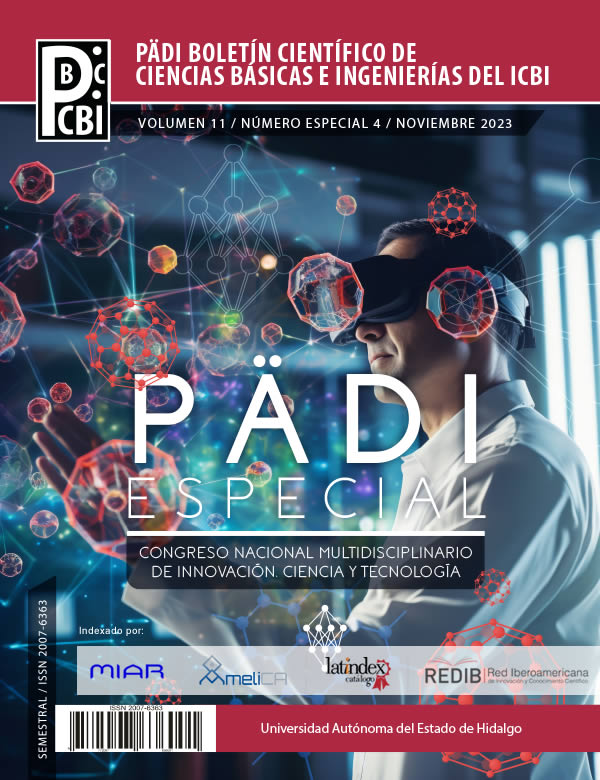Doping of silicon phthalocyanine based organic semiconductor
Abstract
Traditionally, organic compounds have been considered electrical insulators. However, the study of organic semiconductors has led to the development of alternatives to semiconductor silicon, based on π-conjugated molecules such as phthalocyanines. In the present study, chemical doping was carried on silicon phthalocyanine dichloride (SiPcCl2), with a bromide Br-1 substituted dienynoic acid (BrDAc). Resulting doped organic semiconductor was high-vacuum sublimated and deposited onto different substrates as a means to conduct structural, optical, and electric characterization as thin film. For structural characterization, infrared spectroscopy was carried out, and optical parameters were reviewed, such as transmittance and absorbance, obtained by ultraviolet-visible spectroscopy. From these results, energy gaps were determined making use of Tauc’s model. Finally, simple electrical devices: ITO/SiPcCl2-BrDAc/Ag were fabricated and electrically characterized, to assess the behavior when thin semiconductor film SiPcCl2-BrDAc is part of a simple device.
Downloads
References
Al-Muntaser, A.A., El-Nahass, M.M., Oraby, A.H., Meikhail, M.S., Zeyada, H.M., (2018). Structural and optical characterization of thermally evaporated nanocrystalline 5,10,15,20-tetraphenyl-21H,23Hporphine manganese (III) chloride thin films, Optik 167 204–217. DOI: 10.1016/j.ijleo.2018.04.041
Ballinas‑Indili, R., Sánchez‑Vergara, M.E., Toscano, R.A., Álvarez‑Toledano, C., (2020). Synthesis, Doping and Characterization of new Molecular Semiconductors Containing (2E, 4Z)-5, 7-diphenylhepta-2, 4-dien-6-ynoic acids, J Inorg. Organomet. Polym. 30 2509–2519. DOI: 10.1007/s10904-019-01430-7
Cranston, R.R., Lessard, B.H., (2021). Metal phthalocyanines: thin-film formation, microstructure, and physical properties, RSC. Adv. 11 (35) 21716–21737. DOI: 10.1039/D1RA03853B
Darwish, A.A.A., Helali, S., Qashou, S.I., Yahia, I.S., El-Zaidia, E.F.M., (2021). Studying the surface morphology, linear and nonlinear optical properties of manganese (III) phthalocyanine chloride/FTO films, Phys. B: Condens. Matter 622 413355. DOI: 10.1016/j.physb.2021.413355
Dongol, M., El-Nahass, M.M., El-Denglawey, A., Elhady, A.F., Abuelwafa, A.A., (2012). Optical Properties of Nano 5,10,15,20-Tetraphenyl-21H,23H-Prophyrin Nickel (II) Thin Film, Curr. Appl. Phys. 12 (4) 1178–1184. DOI: 10.1016/j.cap.2012.02.051
Dou, L., Liu, Y., Hong, Z., Li, G., Yang, Y., (2015). Low-bandgap near-IR conjugated polymers/molecules for organic electronics, Chem. Rev. 115 (23) 12633–12665. DOI: 10.1021/acs.chemrev.5b00165
El-Mallah, H.M., El Salam, M. A., ELesh, E., El- Damhogi, D.G., (2020). Thermal annealing effect on the structural and optical characteristics of silicon phthalocyanine dichloride thin films, Optik, 200, 163459. DOI: 10.1016/j.ijleo.2019.163459
El-Nahass, M.M., Abd-El-Rahman, K.F., Al-Ghamdi, A.A., Asiri, A.M., (2014). Optical properties of thermally evaporated tinphthalocyanine dichloride thin films, SnPcCl2, Phys. B Condens. Matter. 344 (1–4) 398–406. DOI: 10.1016/j.physb.2003.10.019
El-Nahass, M.M., Farag, A.M., Abd-El-Rahman, K.F., Darwish, A.A.A., (2005) Dispersion studies and electronic transitions in nickel phthalocyanine thin films, Opt. Laser Technol. 37 (7) 513–523. DOI: 10.1016/j.optlastec.2004.08.016
Fazal, T., Iqbal, S., Shah, M., Ismail, B., Shaheen, N., Alrbyawi, H., Al-Anazy, M. M., Elkaeed, E. B., Somaily, H. H., Pashameah, R. A., Alzahrani, E., Farouk, A.-E., (2022). Improvement in Optoelectronic Properties of Bismuth Sulphide Thin Films by Chromium Incorporation at the Orthorhombic Crystal Lattice for Photovoltaic Applications. Molecules, 27 6419. DOI: 10.3390/molecules27196419
Green, M. A., Dunlop, E. D., Yoshita, M., Kopidakis, N., Bothe, K., Siefer, G.,Hao, X., (2023). Solar cell efficiency tables (version 62), Prog. Photovolt. Res. Appl., 31 (7) 651–663. DOI:10.1002/pip.3726
Iwatsu, F., (1988). Size effects on the .alpha.-.beta. transformation of phthalocyanine crystals, J. Phys. Chem., 92 (6) 1678–1681. DOI: 10.1021/j100317a057
Joyner, R.D., Kenney, M.E., (1962). Phthalocyaninosilicon compounds, Inorg. Chem. 1 (2) 236–238. DOI: 10.1021/ic50002a008
Kendall, D.N., (1953). dentification of Polymorphic Forms of Crystals by Infrared Spectroscopy, Anal. Chem. 25 (3) 382–389. DOI: 10.1021/ac60075a002
Laidani, N., Bartali, R., Gottardi, G., Anderle, M., Cheyssac, P., (2008). Optical absorption parameters of amorphous carbon films from forouhi-bloomer and tauc-lorentz models: a comparative study, J. Phys. Condens. Matter 20 (1) 015216. DOI:10.1088/0953-8984/20/01/015216
Ling, H., Liu, S., Zheng, Z., Yan, F., (2018). Organic flexible electronics. Small Methods 2 (10), 1800070. DOI: 10.1002/smtd.201800070
Lüssem, B., Riede, M., Leo, K., (2012). Doping of organic semiconductors, Phys. Status Solidi A. 210 (1) 1–232. DOI: 10.1002/pssa.201228310
Manousiadis, P.P., Yoshida, K., Turnbull, G.A., Samuel. I.D.W., (2020). Organic semiconductors for visible light communications. Phil. Trans. R. Soc. A378, 20190186. DOI:10.1098/rsta.2019.0186
McKeown, N.B., (1998). Phthalocyanine materials: synthesis, structure and function, Cambridge university press, Inglaterra, pp. 2–7.
Mitra, K., Hartman, M.C., (2021). Silicon phthalocyanines: synthesis and resurgent applications, Org. Biomol. Chem. 19 (6) 1168–1190. DOI: 10.1039/D0OB02299C
Mok, T.M., O'Leary, S.K., (2007). the dependence of the Tauc and Cody optical gaps associated with hydrogenated amorphous silicon on the film thickness: αl Experimental limitations and the impact of curvature in the Tauc and Cody plots, J. Appl. Phys. 102 (11) 113525. DOI:10.1063/1.2817822
Newman, C.R., Frisbie, C.D., Da Silva Filho, D.A., Brédas, J-L., Ewbank, P.C., Mann, K.R., (2004). Introduction to organic thin film transistors and design of n-channel organic semiconductors, Chem. Mater. 16 (23) 4436–4451. DOI: 10.1021/cm049391x
Özçeșmeci, M., Nar, I., Hamuryudan, E., (2014). Synthesis and electrochemical and spectroelectrochemical characterization of chloromanganese(III) phthalocyanines, Turk. J. Chem. 38 (6) 1064–1072. DOI: 10.3906/kim-1405-43
Rodríguez-Gómez, A., Sánchez-Hernández, C.M., Fleitman-Levin, I., Arenas-Alatorre, J., Alonso-Huitrón, J.C., Sánchez-Vergara, M.E., (2014). Optical absorption and visible photoluminescence from thin films of silicon phthalocyanine derivatives, Materials 7 (9) 6585–6603. DOI: 10.3390/ma7096585
Seoudi, R., El-Bahy, G.S., El-Sayed, Z.A., (2005). FTIR, TGA and DC electrical conductivity studies of phthalocyanine and its complexes, J. Mol. Struct. 753 (1–3) 119–126. DOI: 10.1016/j.molstruc.2005.06.003
Tauc, J., (1968). Optical properties and electronic structure of amorphous Ge and Si, Mater. Res. Bull. 3 (2) 37–46. DOI: 10.1016/0025-5408(68)90023-8
Torres, T., (2006). From subphthalocyanines to subporphyrins, Angew. Chem. Int. Ed. 45 (18) 2834–2837. DOI: 10.1002/anie.200504265
Touka, N., Benelmadjat, H., Boudine, B., Halimi, O., Sebais, M., (2013). Copper phthalocyanine nanocrystals embedded into polymer host: Preparation and structural characterization, J. Assoc. Arab Univ. Basic Appl. Sci. 13 (1) 52–56. DOI: 10.1016/j.jaubas.2012.03.002
Tsiper, E.V., Soos, Z.G., Gao, W., Kahn, A., (2002). Electronic polarization at surfaces and thin films or organic molecular crystals: PTCDA, Chem. Phys. Lett. 360 (1–2) 47–52. DOI: 10.1016/S00092614(02)007
Zeyada, H.M., El-Nahass, M.M., El-Menyawy, E.M., El-Sawah, A.S., (2015). Electrical and photovoltaic characteristics of indium phthalocyanine
chloride/p-Si solar cell, Synth. Met. 207 46–53. DOI: 10.1016/j.synthmet.2015.06.008
Copyright (c) 2023 Emilio Iván Sandoval-Plata, Ricardo Ballinas-Indili, Cecilio Álvarez-Toledano, María Elena Sánchez-Vergara

This work is licensed under a Creative Commons Attribution-NonCommercial-NoDerivatives 4.0 International License.













